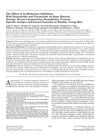TLDR 5ARIs effectively treat and manage BPH by reducing prostate size and symptoms.
Benign prostatic hyperplasia (BPH) was a common issue among older men, characterized by an enlarged prostate and urinary symptoms, potentially leading to complications like acute urinary retention (AUR) or surgery. Dihydrotestosterone played a key role in prostate growth, and 5alpha-reductase inhibitors (5ARIs) such as dutasteride and finasteride were used to treat BPH by inhibiting this hormone's production. These medications were effective in reducing prostate volume, improving urinary flow, alleviating symptoms, and decreasing the risk of AUR and surgery. 5ARIs were the only medical therapy available at the time that could prevent disease progression and provide long-term symptom control, making them essential for men with enlarged prostates at risk of progression.
 72 citations
,
April 2008 in “The Journal of urology/The journal of urology”
72 citations
,
April 2008 in “The Journal of urology/The journal of urology” Dutasteride and finasteride do not significantly affect bone density, blood fats, or blood production, but slightly lower PSA levels and minimally impact sexual function in healthy young men.
 15 citations
,
October 2016 in “Steroids”
15 citations
,
October 2016 in “Steroids” Researchers developed a new method to find substances in herbs that can block a specific enzyme linked to hair loss.
 29 citations
,
April 2019 in “BMJ. British medical journal”
29 citations
,
April 2019 in “BMJ. British medical journal” Men taking dutasteride or finasteride have a slightly higher risk of developing type 2 diabetes.
 57 citations
,
July 2016 in “The Journal of Sexual Medicine”
57 citations
,
July 2016 in “The Journal of Sexual Medicine” 5α-reductase inhibitors increase the risk of sexual dysfunction, especially in men with enlarged prostate.
 15 citations
,
November 2015 in “Pharmacopsychiatry”
15 citations
,
November 2015 in “Pharmacopsychiatry” α-Blockers and 5-ARIs for BPH can cause sexual dysfunction, including erectile and ejaculatory issues.
 11 citations
,
January 2018 in “Asian Journal of Andrology”
11 citations
,
January 2018 in “Asian Journal of Andrology” Dutasteride caused more penile tissue changes than finasteride, possibly increasing erectile dysfunction risk.





